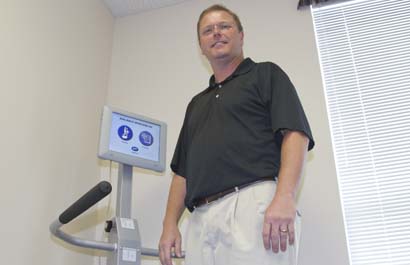- Physical Medicine Home
- Products
- Programs
- Applications
- Find a Clinic
- Blog
- Events
- Education & Training
- In The News
- Press Releases
In The News
< back to resultsNew GMH equipment measures risk of falling, helps reduce chances
August 11, 2011, 4:00am
Balance system said to help agility, muscle tone.
 Quantitative measurement of recovery from a twisted ankle, stroke or knee or hip replacement is now possible locally.
Quantitative measurement of recovery from a twisted ankle, stroke or knee or hip replacement is now possible locally.
Occupational therapist Alan Daup said insurance agents may look more favorably on data they receive from patients using new equipment at Gothenburg Memorial Hospital's Sports & Medical Rehabilitation Center.
The Biodex Balance System SD assesses a patient's risk of fall and later progress—after strengthening exercises—and provides a printout for physicians, insurance companies and patients.
In addition to improving balance, Daup said the system can help increase agility and develop muscle tone.
Rebuilding balance, especially after a fall, ultimately boosts confidence, he said.
How the equipment helps is centered around three components that make up a person's balance—vision, proprioceptors (sensory nerve receptors in muscles, tendons, and joints) and inner ear.
Daup explained that propiceptors furnish information to the central nervous system about body movement and can be affected when a person has a stroke or even suffers a sprained ankle.
A person's inner ear, he said, changes with age.
"Hairs in the inner ear become stiffer," Daup explained.
The new balance system evaluates these components to assess risk of fall and strengthen areas that need improvement.
In assessing risk, a patient stands on a disk that tilts at different levels.
If the assessment is not in the average age range, therapists perform a test which measures how much patients sway with eyes open and closed, on both a hard and foam surface.
That test measures how patients rely on their sight, proprioceptors and inner ear for balance.
Postural stability and weight shifting and weight bearing are also tested.
For example, Daup said someone with a recent hip or knee replacement may be cautioned to place only 25% of his or her weight on the healing leg.
The equipment provides patients visual feedback of what 25% feels like.
Limits of stability are also assessed which show how far patients can reach from their bodies without falling.
Stability can be improved through the system's maze and random control components where patients tilt their bodies to correspond to targets on the touchscreen.
Weak areas are targeted which, for stroke victims, may mean regaining their balance and reducing their dependence on a walker or wheelchair.
"We would work on balancing the left side so they'd learn how to feed themselves with their left hand," Daup explained.
People today live longer which puts them at higher risk for a fall or joint replacement surgery, he said, noting that Gothenburg's aging population are the patients Daup and other therapists see the most.
"People typically become less active and quit doing things as they age," he said. "It is inactivity that can put people at a higher risk of falling."
Those who stay active decrease their chance of falling, Daup said.
Sports & Medical Rehabilitation Center offers initial fall risk screenings at no cost. Appointments can be made by calling 537-4023.
308-537-3636



